Ready to start yoga? Master 10 beginner-friendly poses for strength, flexibility, and stress relief. Get started with the best yoga accessories!
Yoga isn’t just about stretching—it’s a game-changer for your body and mind! If you’re new to yoga, don’t worry. These beginner-friendly poses will help you build strength, improve flexibility, and find your inner zen. Grab your 10mm Yoga Mat for comfort and let’s get started!
1. Cat-cow
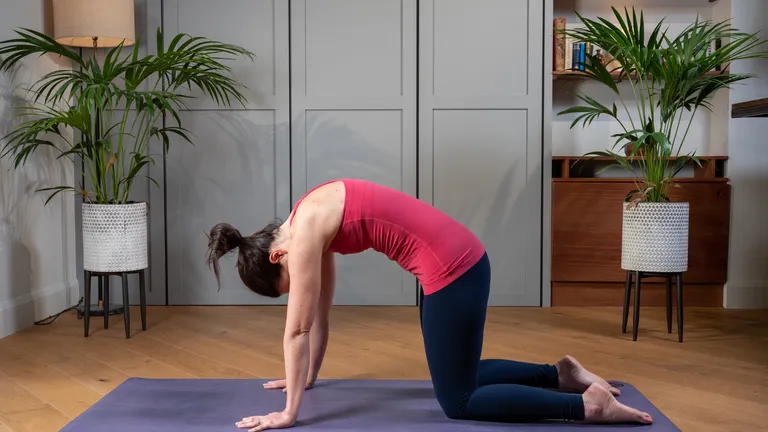
Cat-cow is a gentle yoga stretch for beginners and helps develop an awareness of your breath, allowing you to tune in to how you feel, and offers a whole back stretch for improved spine mobility.
- Start on all fours in a tabletop position with wrists in line with shoulders, knees under hips, and knees hip-width apart. Feel your fingers spreading and pushing into the floor.
- For cat pose, inhale as you look forward, bringing your navel towards the floor, with sitting bones lifting.
- Exhale to cow pose, rounding the spine, bringing chin to chest, and sitting bones under as you press the floor with your hands.
- Repeat both poses five times, synchronizing movements with your breath.
2. Puppy pose
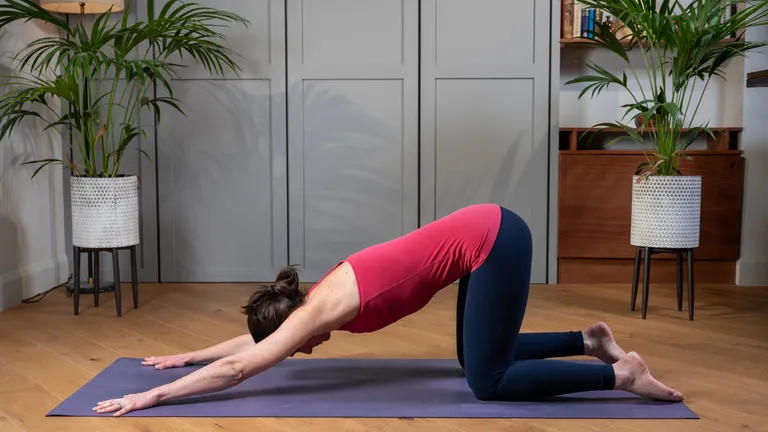
The puppy pose is an excellent warm-up pose for the well-known yoga stretch, downward dog. It helps lengthen your spine and opens your chest and shoulders.
Start your week with achievable workout ideas, health tips and wellbeing advice in your inbox.
- Start on all fours in a tabletop position with wrists in line with shoulders, knees under hips, and knees hip-width apart. Feel your fingers spreading and pushing into the floor.
- Keep your bottom in line with your knees as you take your hands a giant step forward. Your hands can be as wide as the mat, with fingers spread wide.
- Press the floor away from you, feeling like you are gently pressing your chest towards the mat.
- Stay in this position for five breaths.
3. Low lunge
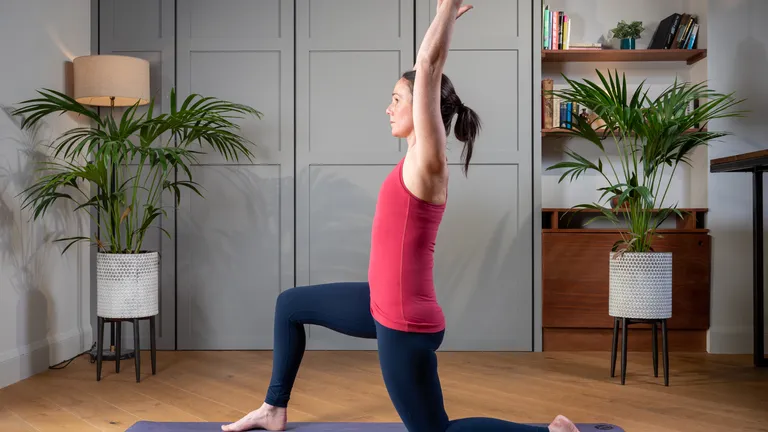
Lunges are a classic workout move, and a fundamental part of several yoga poses, including the low lunge. This position helps stretch your hip flexors and quads, which is helpful if you’ve been sitting down for a while.
If you feel pressure on the back knee, roll your mat slightly to double up or use a cushion or blanket.
- From a tabletop position on all fours, step your right foot forward toward your right hand into a low lunge, keeping your left knee on the ground.
- Bring your arms above your head, keeping them wide apart to make space for the shoulders.
- Stay for a couple of breaths and swap sides.
4. Child’s pose
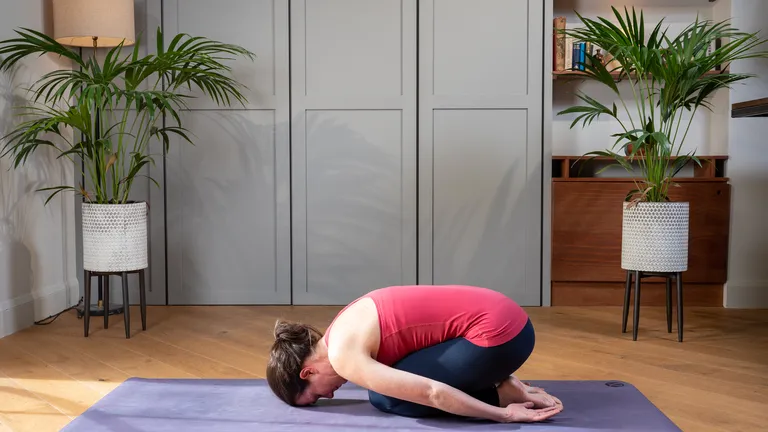
The child’s pose is a restorative resting pose that promotes spinal flexion and allows your back and shoulders to stretch. It’s also an ideal exercise for the end of your regular workouts.
- Bring your bottom back towards your heels from the tabletop position on all fours. Legs can either be together or separated.
- Fold over your thighs and bring your forehead to the floor or a cushion.
- Bring your arms alongside your body with palms facing up.
- Rest here for a few breaths.
5. Downward dog
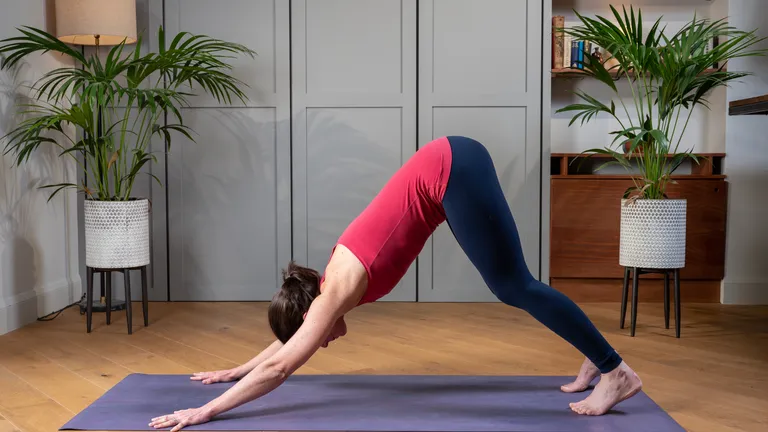
For a good reason, this is one of the most famous yoga stretches for beginners and experienced practitioners—downward dog benefits your whole body, strengthening your arms, lengthening your spine, and giving your hamstrings and calves a stretch.
- Come to all fours with your knees hip distance apart.
- Take your hands a big step forward, landing mat-width apart with your fingers spread.
- Tuck your toes under and lift your knees, then lift your bottom up towards the ceiling. Keep a good bend in the knees (it doesn’t matter if your heels don’t touch the floor) as you press the floor away with your hands. Make sure there is even weight distribution between hands and feet.
- Alternate bending one knee and then the other to stretch out the back of the legs.
- Hold the pose for five breaths.
6. Standing forward fold
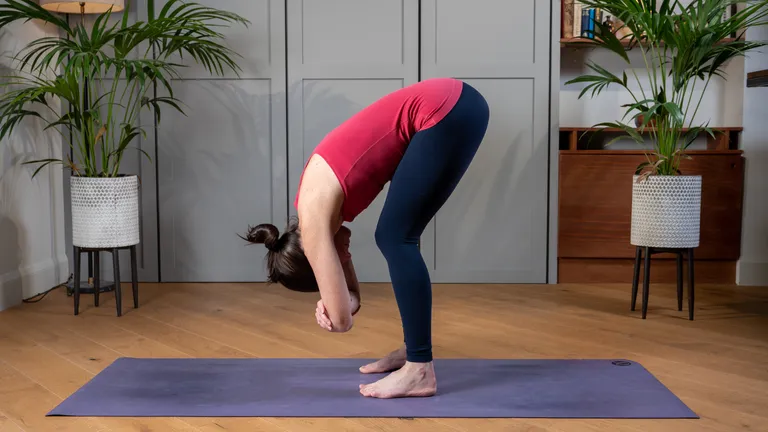
This stretching exercise is relatively straightforward but helps stretch your legs, including your hamstrings and calf muscles, and offers a release along your spine.
- Stand upright with a straight back and arms by your sides, with a slight bend in your knees.
- Bring your hands to opposite elbows, hinge at the hips, and fold your torso forward over your thighs. Your weight should be evenly split between both feet and legs.
- You can rock back and forwards a little, alternating your weight between your toes and heels.
- Stay in this position for five breaths.
7. Warrior 2
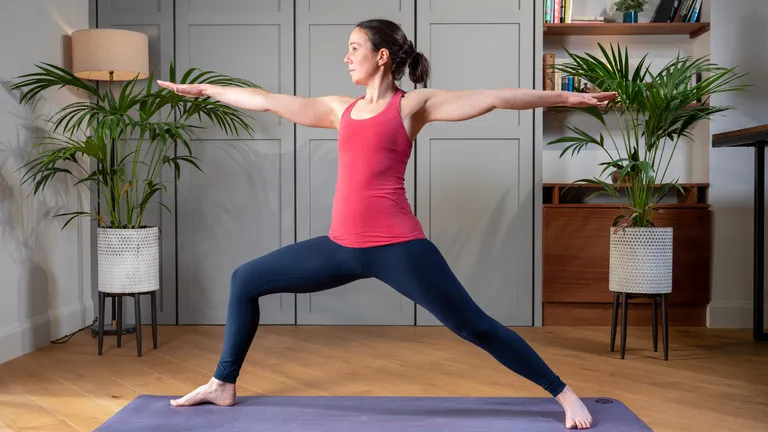
As you’d expect for a pose with this name, Warrior 2 is a great strengthening yoga pose. It develops your legs and opens your hips and chest, and improving your shoulder’s range of motion.
- Adopt a wide stance, facing the long side of the mat.
- Turn your right foot to face the short edge of the mat, then bend your right knee over your right foot, moving your shin vertically and coming into a lunge.
- Open your arms so they’re horizontal and parallel to the long side of the mat. Look towards your right fingertips, and stay here for five breaths.
- Return to the starting position, bringing your right foot in.
- Turn your left leg to face the other short edge of the mat. Repeat on the other side.
8. Triangle pose
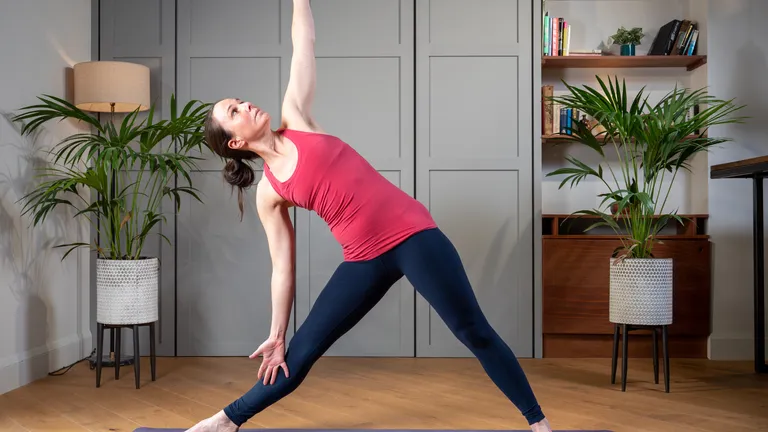
The triangle pose stretches your inner leg and hamstrings while opening the chest and improving the range of motion for the spine.
- Stand with your legs wide and turn your right toes to the short edge of your mat and turn your left toes in about 45 degrees.
- Straighten your right leg as you extend your arms wide and reach up and over, doing a cartwheel motion with your upper body. Your right hand should come to rest somewhere along your inner right leg.
- Turn your torso and left collarbone towards the ceiling and reach the left arm directly up, coming into a triangle shape.
- Stay in this position for five breaths, then bend the right knee to come out of the pose. Repeat on the other side.
9. Wide-legged forward fold
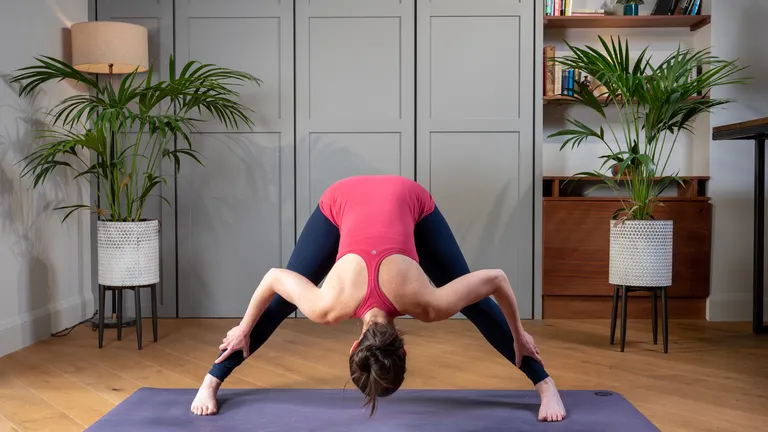
This soothing wide-legged forward fold is like the earlier standing forward fold but also helps stretch the back of your legs and offers a spine and neck release.
- Stand upright with a straight back and your arms by your sides. Your feet should be wide as you turn your toes to face the long edge of the mat.
- Bend your knees slightly and fold your torso towards the thighs, so the crown of your head releases towards the floor. Hands can come to your thighs, shins, feet, or the mat. Check the weight is evenly distributed through your feet.
- Stay for five breaths, then soften your knees and roll gently up.
10. Bridge pose
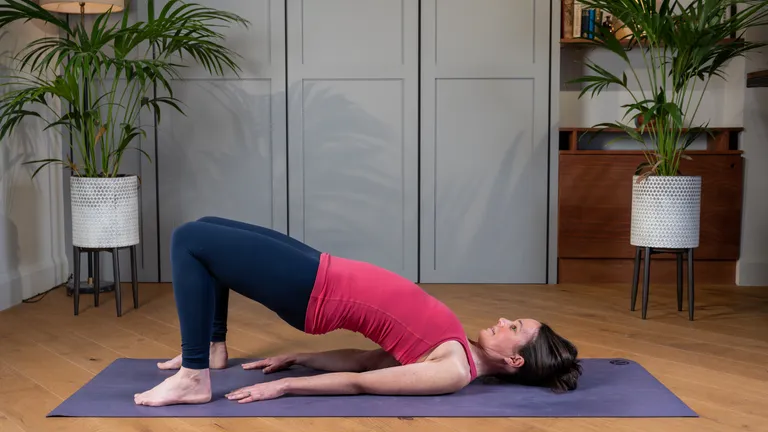
The bridge pose strengthens your legs, activates your glutes (the large muscles in your upper leg), lengthens your hip flexor and quads, opens your chest, and helps improve your spinal range of motion.
- Lie on the mat with knees bent and feet on the floor a little wider than your hips, with arms by your sides.
- Press into your feet and squeeze your glutes to press the hips towards the ceiling. Your feet should remain firmly on the floor as you lift your front body.
- Ensure your shoulders stay on the ground, and squeeze your shoulder blades together to broaden your chest.
- Hold this position for five breaths, then slowly lower to the floor.
Must-Have Yoga Accessories for Beginners
Yoga helps strengthen the connection between your mind and body physically, while meditation lets you focus on your breath so that you notice your thoughts but can let them pass by without getting distracted by them.
A good yoga session starts with the right yoga accessories. A comfy mat, like the 10mm Memory Foam Yoga Mat or the 15mm Memory Foam Yoga Mat, will protect your joints and keep you stable.
Frequently Asked Questions
Start with 2–3 sessions per week. As you gain confidence, practice more often!
A 10mm yoga mat is ideal for most, while a 15mm yoga mat offers extra cushioning.
Yes, eco-friendly yoga mats made from natural materials like rubber or jute can be quite durable, especially with proper care.
The most important feature depends on your priorities. Grip, thickness, and material are all key factors to consider based on your practice style and personal preferences.
Aim for 20–30 seconds when starting. Increase the duration as you improve.
Just a quality yoga mat! Blocks and straps can help, but they’re optional.

